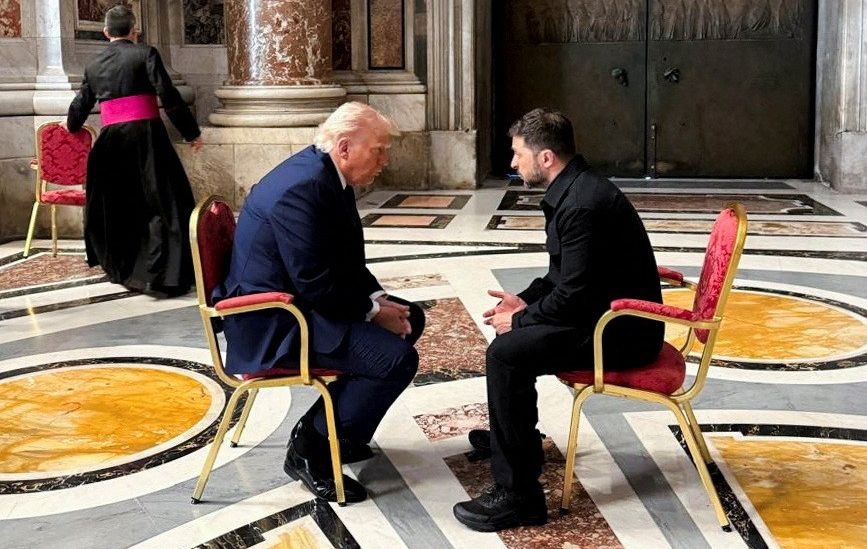The U.S.-Ukraine minerals agreement is not a diplomatic breakthrough and will not end the war, but it is a significant success for Ukraine, both in the short term and — if it is ever in fact implemented — in the longer term.
It reportedly does not get Ukraine the security “guarantees” that Kyiv has been asking for. It does not commit the U.S. to fight for Ukraine, or to back up a European “reassurance force” for Ukraine. And NATO membership remains off the table. Given its basic positions, there is no chance of the Trump administration shifting on these points.
But since the Ukraine peace process appeared to run out of steam, and Trump threatened to “walk away” from the talks, Kyiv and Moscow have been engaged in an elaborate diplomatic dance of semi-proposals and hints to try to ensure that if Trump does walk away, he will blame the other side for the talks’ failure.
This agreement makes it far more likely that he will blame Russia, and therefore that he will continue military and intelligence aid to Ukraine. He may also, as threatened, try to impose additional sanctions on Russia — though given the resistance of most of the world to these sanctions, and tensions over tariffs between the U.S. and Europe, it is not at all clear how effective new sanctions would be.
Continued U.S. military and intelligence aid will not win the war for Ukraine, nor allow it to drive the Russians from occupied territory. It will however help the Ukrainian army to slow down Russia’s advance on the ground and impose heavy casualties on the Russian army. This should not be taken by the Ukrainians or their European supporters as an excuse to maintain impossible conditions for peace that will make a settlement impossible; because the military and economic odds are still strongly against Ukraine, and a collapse of Ukraine’s exhausted troops is a real possibility.
However, it will make it more likely that Russia will abandon or heavily qualify its impossible demands, for example for Ukrainian disarmament and withdrawal from additional territory.
As far as the deal itself is concerned, it is clearly far more favorable for Ukraine than Trump’s original — and grotesque — proposal that Ukraine should essentially hand its entire reserves of minerals to the U.S. in compensation for U.S. aid. Under the new agreement, the profits of mineral extraction will be equally shared.
As Treasury Secretary Scott Bessent said: “This agreement signals clearly to Russia that the Trump administration is committed to a peace process centered on a free, sovereign, and prosperous Ukraine over the long term. … President Trump envisioned this partnership between the American people and the Ukrainian people to show both sides’ commitment to lasting peace and prosperity in Ukraine. And to be clear, no state or person who financed or supplied the Russian war machine will be allowed to benefit from the reconstruction of Ukraine.”
Nor under this deal will any U.S. money go to develop mineral extraction in the Russian-occupied areas of Ukraine.
According to Trump, “The American presence will, I think, keep a lot of bad actors out of the country or certainly out of the area where we’re doing the digging."
Despite Western rhetoric, absolute Western security guarantees for Ukraine after a peace settlement have never really been on offer, because the Biden administration and almost every other NATO government stated repeatedly that they would not fight to defend Ukraine. This deal, if implemented, will however ensure a strong continued U.S. interest in Ukraine. It greatly reduces the risk that in the event of future Russian aggression, the U.S. would simply look away and not respond as it has in this war, with military supplies and extreme sanctions.
But the deal won’t be implemented until the war comes to an end. Thereafter, it will depend on the willingness of U.S. private companies to invest in this sector — and that will depend on their assessment of both the risks and the profits involved. For it is vital to note that this agreement does not commit the U.S. government to invest in Ukraine; and to judge by the present profitability of minerals extraction in the world, it is not certain that private investors will see major benefits from doing so.
China has developed its rare-earth sector on such a scale mainly through huge state-directed investment; and no-one has so far done a thorough analysis of the actual profitability and scale of most of these Ukrainian resources. So, only a tactical success for Ukraine and one over which there hang many questions; but nonetheless one that hopefully will lead Moscow to respond with some serious and acceptable peace proposals of its own.
- Ukraine War is great for the portfolio, as defense stocks enjoy a banner year ›
- A window has opened to end the war in Ukraine ›
- Trump has a mandate to end the Ukraine War ›
- Diplomacy Watch: Lindsey Graham pushing new sanctions on Russia | Responsible Statecraft ›
- Trump's silence on loss of Ukraine lithium territory speaks volumes | Responsible Statecraft ›
















